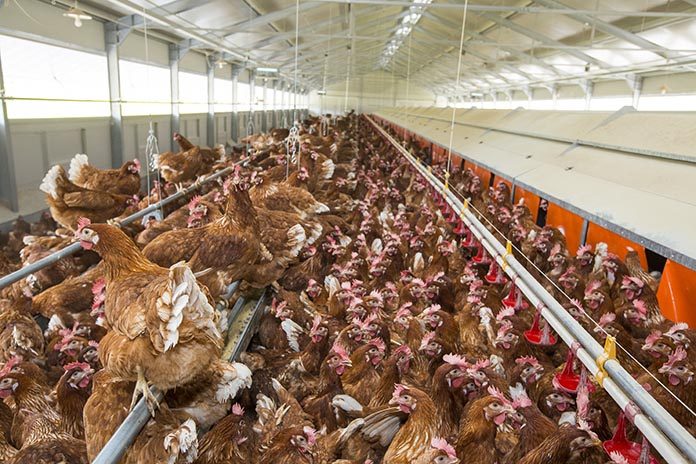
Missouri has a large amount of egg production that uses alternative housing methods such as cage-free farming. The development of the alternative systems began around 2008. Most of the cage-free egg production utilizes single age farms that have 10,000 to 25,000 brown hen flocks in single deck houses.
There is a scratch area around the outside edge. Conventional, organic, and pasture systems are used singly or in combinations. One of the unique disease conditions that has shown up in the cage-free flocks is Spotty Liver Disease. It is generally seen in the 30- to 48-week age range. There is usually outdoor access or, sometimes, dirt scratch areas. Production can decline 10% or more over 1 to 2 weeks (from middle 90% range down to middle 80% range or lower).
Death loss among the hens may ramp up quickly, from 2 to 5 dead per week to 20 or 30 dead per day. Weak hens may be visible in the flock. When the dead birds are examined, they are in production, the bodies are in good flesh, and there are adequate abdominal fat pads. Sometimes the body cavity contains clear watery fluid and a few stands of protein precipitate. The dead hens always have 1 to 2 mm diameter white spots on the livers.
Sometimes there will also be red spots. The crops and gizzards may contain muddy material mixed with the feed. Microscopically the spots are foci of acute necrosis and inflammation. Bacterial cultures often do not produce any growth or light growths of bacteria such as E. coli. The hens usually have intestinal worms but not in unusual numbers.
The disease has been managed using chlortetracycline (Aureomycin brand) in the feed. Some production systems, however, do not allow the use of antibiotics. There are anecdotal reports that high levels of citric acid or bleach in the water greatly decrease the severity of the outbreak. Many of the flocks seem to develop resistance after 4 to 6 weeks, although death loss can be high. Changing of the season from hot weather to cool also seems to greatly decrease the incidence or eliminate the disease. Many producers prefer to confine their hens while treating them.
Researchers in several countries have isolated Campylobacter hepaticus from cases of the disease. Koch’s postulates have been fulfilled with some of the isolates. This is a very fastidious and slow-growing organism in the laboratory. It is rarely isolated routinely. Campylobacter jejuni is sometimes isolated but it has been proven that it is not the cause of Spotty Liver Disease. Occasionally, Gallibacterium anatis is isolated from similar cases. Usually when it is the cause, there will be other systems involved, such as the reproductive tract.
A similar condition called Avian Vibrionic Hepatitis was seen until the 1960’s. The comment in the textbooks is that it disappeared with advent of caged production and no further investigation was performed. Vibrio-like organisms had been isolated at that time and some of these cultures were saved. The preserved cultures, however, could not be revived when an attempt was made in the 1980’s. Therefore, it cannot be determined if Spotty Liver Disease is the same as Avian Vibrionic Hepatitis.
From the Proceedings of the – 2019 Midwest Poultry Federation Convention

















